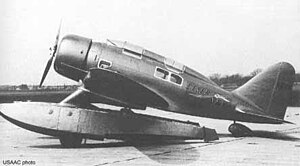Seversky SEV-3
| SEV-3 | |
|---|---|
 |
|
| Role | Three-seat amphibian |
| National origin | United States |
| Manufacturer | Seversky Aircraft |
| Designer | Alexander Kartveli |
| First flight | 1933 |
The Seversky SEV-3 was an American three-seat amphibian monoplane, the first aircraft designed and built by the Seversky Aircraft Corporation.
The SEV-3 was an all-metal cantilever low-wing monoplane powered by a nose-mounted 420 hp (313 kW) Wright J-6 Whirlwind radial engine. It had two cockpits in tandem, a forward cockpit for the pilot and a rear cockpit for two passengers, both with sliding canopies. It could either be fitted with twin amphibious floats which had main wheels fitted in the floats to allow it to operate from land, or with a fixed tailwheel undercarriage with the mainwheels enclosed in large fairings.
The SEV-3 first flew as a floatplane in June 1933, demonstrating excellent performance as both an amphibian and a landplane. It was built in small numbers mainly for export.
An SEV-3 established a world speed record for piston-engined amphibians in 1933, and on 15 September 1935, a Wright Cyclone-powered SEV-3 set a record of 230 mph (370.8 km/h) which stood for 49 years. A landplane version was also developed with conventional landing gear.
The design influenced a long line of Seversky and later Republic aircraft, eventually leading to the development of the P-47 Thunderbolt. A landplane version was used by the United States Army Air Corps as a basic trainer with the designation BT-8.
Data from United States Military Aircraft since 1909
General characteristics
Performance
...
Wikipedia
